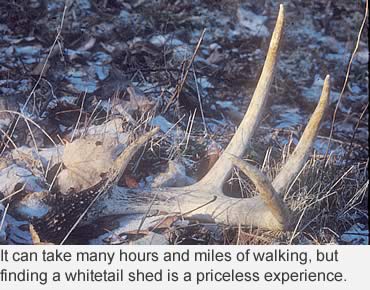Who says deer hunting ends in the fall?
Whether you're trying to keep tabs on which bucks made it through winter or you're just looking for a fun family-oriented activity, shed hunting is a great way to spend some quality time outdoors. Before you head out, however, what follows are a few quick tips to make your hunt more successful.
WHEN
You can find sheds any time of year, but if you want the best odds at a fresh crop, target peek periods. Northerners have a slight disadvantage since they sometimes have to wait for all the snow to melt, but even in the South, timing is important.
Go too early - before most deer have shed their antlers – and you're wasting time. Go too late, and the antlers get chewed by rodents or picked up by other shed hunters. Like the rut, it might take a few seasons to learn the optimum dates. Unlike the rut, peak shedding can vary from one year to the next, so don't refine your shed hunting window too tightly.
 HOW
HOW
Just as there are techniques to be more successful hunting deer, there are tactics that can help you find more antlers. One is simply covering a lot of ground. When viewed in terms of miles or hours per antler, shed hunting is not a particularly productive practice. Fortunately, it's fun, sometimes rewarding and a great source of exercise. You can also be more efficient by combining shed hunting and scouting.
Another way to improve efficiency is by riding instead of walking. In open country, you can cover a ton of ground on an ATV. If you have a SxS vehicle, one person can drive while the other looks for sheds.
Proficiency comes with practice. With time and experience, you develop a search image. Your brain becomes trained to pick out the general shape and color of an antler, even from a distance. As you become more proficient, you can scan larger areas in less time. And just as the best deer hunters learn to look not for a deer but for parts of a deer, shed hunters should look for parts, shapes and color. You may only see the tip of a tine poking through the snow or out of the mud.
 WHERE
WHERE
As whitetails most often shed antlers when winter food is most important, concentrated food sources are a good place to start. These can vary from one region or habitat to another and may include agricultural fields, food plots, cutovers, orchards or hard mast stands.
The next most important habitat during shedding season is cover. In the north, that often means dense softwoods, particularly bottoms. In rugged country it might mean draws, while open terrain includes south-facing slopes.
In and around these areas, focus on edges with dips, depressions, heads of ravines and low spots shielded from prevailing winds – bedding areas. These are reliable shed producers. Next, walk the trails leading away from feeding and bedding areas.
As you walk, look for any place where a deer has to jump across or over something, like a fence, a creek or a fallen log. The impact of landing can cause loose antlers to drop, so locations where deer have to jump are more likely to produce sheds. If you find a shed, mark the location on your favorite phone mapping app and begin walking circles or grids to look for the shed's mate.
MAN'S BEST FRIEND
Dogs are great antler-hunting companions. Some have a natural instinct for it, while others can be trained. In either case, dogs can become quite proficient at finding sheds, and they cover a lot more ground than you can. They're also a lot more willing to go into the dense tangles that you avoid – the ones that sometimes hold the biggest sheds.
Dog breed isn't critical, although some seem to be better than others. I knew a very successful shed hunter who had a dachshund. Obviously, the more training a dog receives, the better hunter it will be.
Read Recent Articles:
• The Plot Thickens: How to get the most from your food plot efforts.
• The Exception to the Rule: Never shoot a buck on the first day of a Kansas bowhunt.
Subscribe today to have Buckmasters delivered to your home.